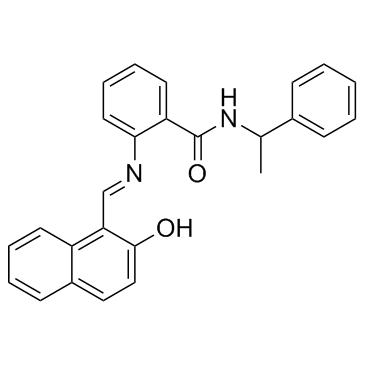| Cas No.: | 410536-97-9 |
| Chemical Name: | 2-[[(2-hydroxy-1-naphthalenyl)methylene]amino]-N-(1-phenylethyl)-benzamide |
| Synonyms: | Sir Two Inhibitor Naphthol |
| SMILES: | O=C(NC(C1=CC=CC=C1)C)C2=CC=CC=C2/N=C/C3=C4C=CC=CC4=CC=C3O |
| Formula: | C26H22N2O2 |
| M.Wt: | 394.47 |
| Sotrage: | 2 years -20°C Powder, 2 weeks 4°C in DMSO, 6 months -80°C in DMSO |
| Description: | Sirtinol is a sirtuin inhibitor, with IC50s of 48 μM, 57.7 μM and 131 μM for ySir2, hSIRT2 and hSIRT2, respectively. |
| In Vivo: | Sirtinol has anti-inflammatory effects through direct inhibition of HNE activity and attenuates HNE-induced and LPS-mediated tissue or organ injury[3]. |
| In Vitro: | Sirtinol reduces the growth of MCF-7 cells in a concentration- and time-dependent manner. The IC50 values of sirtinol are 48.6 μM and 43.5 μM after 24 and 48 h of treatment, respectively. Sirtinol significantly decreases SIRT1 expression and increases the acetylated p53 level[1]. Sirtinol attenuates the proliferation and induces apoptosis of nonsmall cell lung cancer (NSCLC) H1299 cells and causes the significantly increased level of FoxO3a, a proapoptotic transcription factor targeted by Sirt1[2]. |

 DC Chemicals' products qualify for U.S. tariff exemptions. We guarantee no price increases due to customs duties and maintain stable supply, continuing to deliver reliable research solutions to our American clients.
DC Chemicals' products qualify for U.S. tariff exemptions. We guarantee no price increases due to customs duties and maintain stable supply, continuing to deliver reliable research solutions to our American clients.





















